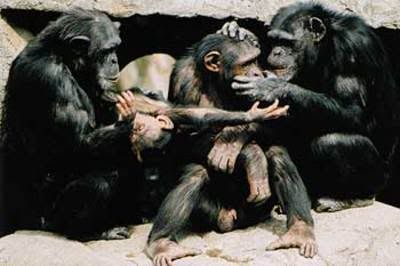Tit-for-tat a common pattern across primate species

Grooming reciprocity common in our evolutionary cousins.
Image: Unattribated
It is one of the oldest questions of philosophy: why are people good and why should we be kind to each other. Research with nonhuman primates is beginning to bring an answer to this age-old question: return benefits.
Thirty years ago Robert Trivers developed the framework of reciprocal altruism. His hypothesis predicted that social organisms would benefit others if the cost to themselves was less than what the expected returns were likely to be. This hypothesis has been successfully tested for species ranging from ants to lions, and now a new analysis can confidently add primates to this list.
Writing in the journal Biology Letters, Gabriele Schino and Filippo Aureli report that across 22 different species and 12 genera of primates females will preferentially groom others that preferentially groom them. Previous studies have suggested that primates will direct their grooming up the hierarchy, in the nonhuman version of social networking. However these studies suggest that a trusted grooming companion was more important in the decision of whom to groom in return than was rank or relationship.
Imagine that? Fairness and gratitude as a common tactic in nonhuman primates? Meanwhile our country is vetoing health care for poor kids because we’d prefer that every family of four dole out $20,000 per year for our war in Iraq (roughly $800,000,000 total). It appears we’re lacking the basic decency found in our primate relatives. We’d better find a way to get it back and construct a more cooperative society, otherwise you may find yourself one day with no one willing to come to your aid during a time of need.




















2 comments:
So true.
I've always wondered why it is females who seem to be more involved in grooming. Any thoughts on that?
(p.s. It's super neat you met Frans)
Holly,
That's a great question. I know that in most primates females will remain in the troop they were born and would therefore be more likely to show affiliation with one another based on kin selection. However, this isn't the case in chimps and bonobos. Females migrate to other troops at puberty. Chimpanzee males will groom each other more than females will groom each other as would be expected. However, the opposite condition is found in bonobos that, to my knowledge, has not been adequately explained (but I'm working on it).
The best paper I know of off hand that explores some of these issues is by Sterck, Watts and van Schaik.
Great interview with Marc Hauser, by the way.
Post a Comment